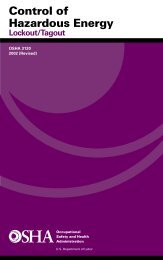Toxic Chemical Release Inventory Reporting Forms and Instructions
Toxic Chemical Release Inventory Reporting Forms and Instructions
Toxic Chemical Release Inventory Reporting Forms and Instructions
Create successful ePaper yourself
Turn your PDF publications into a flip-book with our unique Google optimized e-Paper software.
Table II<br />
Note: <strong>Chemical</strong>s may be added to or deleted from the list. The Emergency Planning <strong>and</strong> Community Right-to-Know Call<br />
Center, 800 424-9346, or 703 412-9810, will provide up-to-date information on the status of these changes. See section B.3.c of<br />
the instructions for more information on the de minimis values listed below. There are no de minimis levels for PBT chemicals<br />
since the de minimis exemption is not available for these chemicals (an asterisk appears where a de minimis limit would<br />
otherwise appear in Table II). However, for purposes of the supplier notification requirement only, such limits are provided in<br />
Appendix D.<br />
<strong>Chemical</strong> Qualifiers<br />
This table contains the list of individual EPCRA Section 313<br />
chemicals <strong>and</strong> categories of chemicals subject to 2003 calendar<br />
year reporting. Some of the EPCRA Section 313 chemicals listed<br />
have parenthetic qualifiers listed next to them. An EPCRA<br />
Section 313 chemical that is listed without a qualifier is subject<br />
to reporting in all forms in which it is manufactured, processed,<br />
<strong>and</strong> otherwise used.<br />
Fume or dust. Two of the metals on the list (aluminum <strong>and</strong><br />
zinc) contain the qualifier “fume or dust.” Fume or dust refers to<br />
dry forms of these metals but does not refer to “wet” forms such<br />
as solutions or slurries. As explained in Section B.3.a of these<br />
instructions, the term manufacture includes the generation of an<br />
EPCRA Section 313 chemical as a byproduct or impurity. In<br />
such cases, a facility should determine if, for example, it<br />
generated more than 25,000 pounds of aluminum fume or dust in<br />
the reporting year as a result of its activities. If so, the facility<br />
must report that it manufactures “aluminum (fume or dust).”<br />
Similarly, there may be certain technologies in which one of<br />
these metals is processed in the form of a fume or dust to make<br />
other EPCRA Section 313 chemicals or other products for<br />
distribution in commerce. In reporting releases, the facility<br />
would only report releases of the fume or dust.<br />
EPA considers dusts to consist of solid particles generated by any<br />
mechanical processing of materials including crushing, grinding,<br />
rapid impact, h<strong>and</strong>ling, detonation, <strong>and</strong> decrepitation of organic<br />
<strong>and</strong> inorganic materials such as rock, ore, <strong>and</strong> metal. Dusts do<br />
not tend to flocculate, except under electrostatic forces.<br />
EPA considers a fume to be an airborne dispersion consisting of<br />
small solid particles created by condensation from a gaseous<br />
state, in distinction to a gas or vapor. Fumes arise from the<br />
heating of solids such as lead. The condensation is often<br />
accompanied by a chemical reaction, such as oxidation. Fumes<br />
flocculate <strong>and</strong> sometimes coalesce.<br />
Manufacturing qualifiers. Two of the entries in the EPCRA<br />
Section 313 chemical list contain a qualifier relating to<br />
manufacture. For isopropyl alcohol, the qualifier is “only persons<br />
who manufacture by the strong acid process are subject, no<br />
supplier notification.” For saccharin, the qualifier is “only<br />
persons who manufacture are subject, no supplier notification.”<br />
For isopropyl alcohol, the qualifier means that only facilities<br />
manufacturing isopropyl alcohol by the strong acid process are<br />
required to report. In the case of saccharin, only manufacturers<br />
of the EPCRA Section 313 chemical are subject to the reporting<br />
requirements. A facility that processes or otherwise uses either<br />
EPCRA Section 313 chemical would not be required to report for<br />
those EPCRA Section 313 chemicals. In both cases, supplier<br />
notification does not apply because only manufacturers, not users,<br />
of the EPCRA Section 313 chemical must report.<br />
Ammonia (includes anhydrous ammonia <strong>and</strong> aqueous<br />
ammonia from water dissociable ammonium salts <strong>and</strong> other<br />
sources; 10 percent of total aqueous ammonia is reportable<br />
under this listing). The qualifier for ammonia means that<br />
anhydrous forms of ammonia are 100% reportable <strong>and</strong> aqueous<br />
forms are limited to 10% of total aqueous ammonia. Therefore<br />
when determining threshold <strong>and</strong> releases <strong>and</strong> other waste<br />
management quantities all anhydrous ammonia is included but<br />
only 10% of total aqueous ammonia is included. Any<br />
evaporation of ammonia from aqueous ammonia solutions is<br />
considered anhydrous ammonia <strong>and</strong> should be included in<br />
threshold determinations <strong>and</strong> release <strong>and</strong> other waste<br />
management calculations.<br />
Sulfuric acid <strong>and</strong> Hydrochloric acid (acid aerosols including<br />
mists, vapors, gas, fog, <strong>and</strong> other airborne forms of any<br />
particle size). The qualifier for sulfuric acid <strong>and</strong> hydrochloric<br />
acid means that the only forms of these chemicals that are<br />
reportable are airborne forms. Aqueous solutions are not covered<br />
by this listing but any aerosols generated from aqueous solutions<br />
are covered.<br />
Nitrate compounds (water dissociable; reportable only when<br />
in aqueous solution). The qualifier for the nitrate compounds<br />
category limits the reporting to nitrate compounds that dissociate<br />
in water, generating nitrate ion. For the purposes of threshold<br />
determinations the entire weight of the nitrate compound must be<br />
included in all calculations. For the purposes of reporting<br />
releases <strong>and</strong> other waste management quantities only the weight<br />
of the nitrate ion should be included in the calculations of these<br />
II–2 <strong>Toxic</strong>s <strong>Release</strong> <strong>Inventory</strong> <strong>Reporting</strong> <strong>Forms</strong> <strong>and</strong> <strong>Instructions</strong>
















